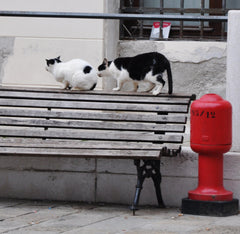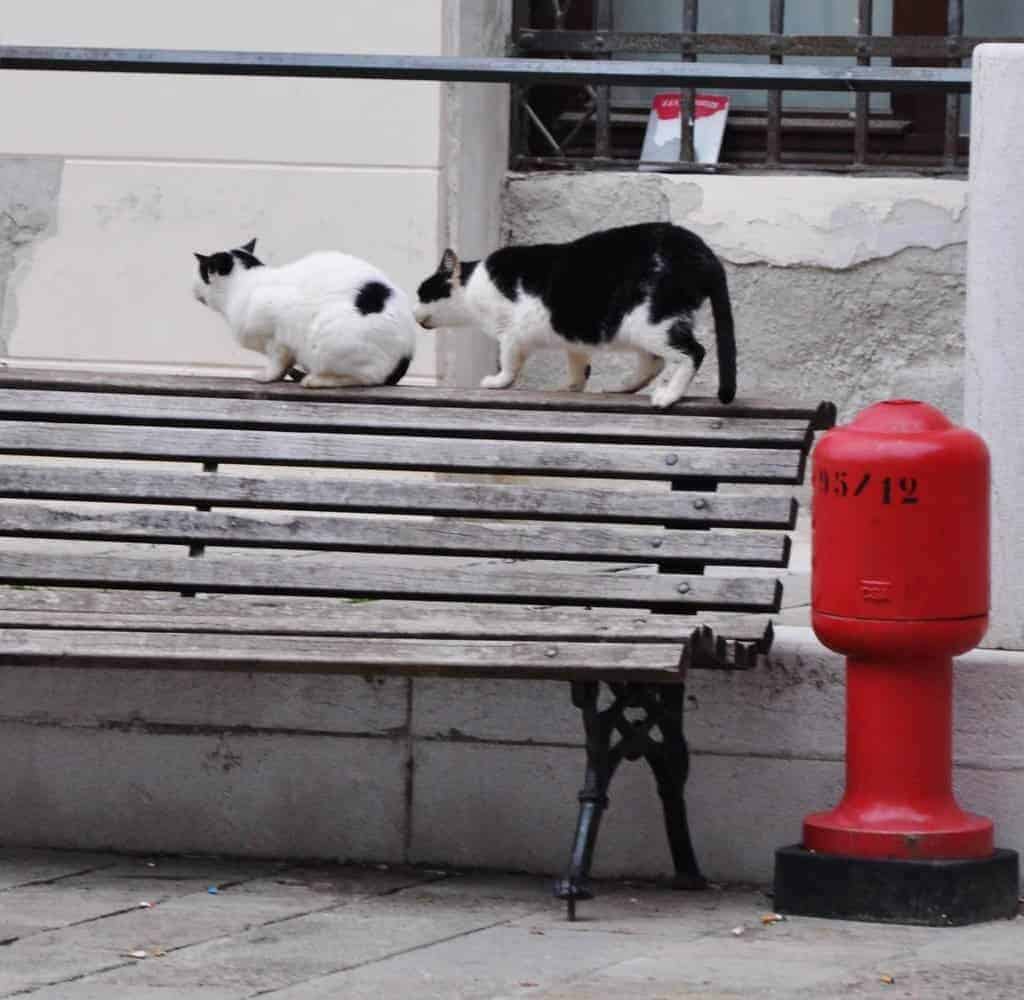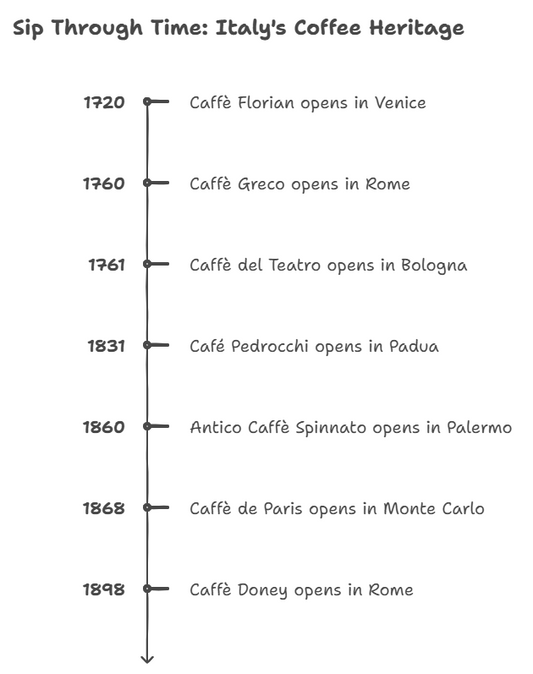
Shakespeare’s Shylock declared that the cats of Venice were “both necessary and harmless.” Venetians believe that cats helped save the city from the devastating plague of 1348 by killing diseased rats. However, from time to time the municipality has tried to reduce the teeming feline population. Each time the citizenry has been up in arms in protest. In 1960 there were over 12,000 stray cats in Venice. The cat ladies, known as gattare, provided food and water to colonies located in almost every neighborhood in the city.
Largely due to the efforts of an organization, oddly named Dingo, the number has been reduced to 2,000 without killing a single healthy cat. Founded in 1965, Dingo was started by British-born Helena Sanders and Venetian Elena Scarpabolla as a cat and dog rescue society. (Dingo was the name of the first rescued dog.)
It took Dingo 20 years, but finally Venetian authorities gave them a designated space, a gattile or cattery, on the abandoned island of San Clemente, an ancient pilgrimage site that in the 19th century served as an insane asylum for women and was finally closed down after World War II. Imposing 19th-century buildings were still intact, as was an exquisite Baroque church, though it was stripped of its most precious artworks by thieves when the island was uninhabited and unguarded. The cat sanctuary brought people to the island again.
But in 2005, Isola San Clemente was sold for redevelopment as a luxury hotel and resort. Almost 250 cats (stray dogs were not part of the mandate by this time) were transported to Malamocco, a fishing village on the long sandbar that is the Lido of Venice.
Dingo is now part of the Anglo Italian Society for the Protection of Animals, a British based charity which raises funds worldwide for animal welfare organizations in Italy. AISPA was started in 1952 and has branches all over Italy. AISPA is concerned about the welfare of all kinds of animals, from cats and dogs to livestock and circus animals.
The gattile is housed in a small group of buildings in Malamocco. There are cat dormitories with individual cages, a surgery, and a series of outdoor enclosures where most of the cats hang out. There are also quarantine huts and a convalescence ward, for short- and long-term care of the injured and ailing residents. The farthest building houses the isolation ward for cats suffering from infectious illnesses like feline immunodeficiency virus (FIV) and panleukopenia (feline distemper) and a maternity ward for those about to give birth.

There is an ever-expanding and contracting population of about 200 cats. Unwanted, sick or stray cats are brought to Dingo, either by Dingo volunteers or Venetian residents. Each new resident is given a medical exam and a determination is made whether they are lost, abandoned or feral. When its needs have been assessed, it joins the colony, some only for a short while. The gattile has an active adoption program and most of the captured feral cats are returned to their original colonies throughout Venice once they have been spayed or neutered. Unlike the U.S., where strays may be euthanized, Italy has laws to protect animals, wanted or unwanted. Most cities have TNR programs to trap, neuter and release feral cats. Venice was the first Italian city to pass an animal rights Act, in 1987 (adopted nationally in 1991), and it guarantees stray cats an area to live in freedom.
On Robin Saikis’s website TheVeniceLido.com one can find this interesting snippet of history: “In Gaetano Zompini’s 1789 book about Venetian street traders we learn about knife-sharpeners, candle-sellers, and wig-makers, but there is another intriguing trade, that of the castragatti, the cat-neuterers. The cat population of Venice had always been a problem but Venetians, as animal lovers, were always ready to try and compromise with their feline friends: cats kill rats, rats spread the plague, so neutering the toms would have seemed a good way of keeping a useful ally under control.”
Dingo also maintains some kitty condos in various neighborhoods in Venice for the free feral colonies. Londoner Jeff Cotton keeps track of the colonies on his website Fictional Cities.
Having mentioned the cats of Venice and their many related mysteries so often in my trip reports I thought that it would be good to bring these strands together in one place.
Having not been to Venice since 1992 I was surprised on my 2002 visit to find that the large number of friendly strays living in many campi (sometimes in little makeshift wooden huts) and being fed foil dishes of pasta by old ladies had all disappeared, completely. The small garden in front of San Zaccaria, the Garibaldi Gardens, the wide canal-side area behind the Scuola Grande di San Rocco - all areas that seemed very empty without their resident tabbies. This seemed to me to be a somewhat tragic loss, as Venice was justly famous for its cat population. And where had they all gone?
This top part of this page features photos I took in the early 90s when the cats were many. Further down you'll find more recent bulletins.
A solution to the above disappearing cats' mystery was supplied by author and Venice resident Michelle Lovric who wrote to me in 2005 saying "There is an association called Dingo which has over the last ten years collected up most of the street cats and taken them away for sterilization and rehousing. For some time they were housed on the island of San Clemente, the old female lunatic asylum. I went to visit them there - it was amazingly well organized, with huge cages and an operating theatre for the cats. But then the island was sold (it is now a five-star hotel) and the cats were deported to the Lido, where they now have a sanctuary. Some Venetian friends have told me that the cats were accused of causing diseases to Venice's few precious babies and small children."
Here is a contemporary New York Times article about the fuss at the time of the move from San Clemente to the Lido.
This situation was confirmed and bemoaned by a multiple-cat-owning bookshop owner I got talking to on my 2006 visit who thought that the ecologists were misguided in this move, not the least in thereby leaving rats in Venice with no predators, this being the purpose for which the cats had first been introduced to Venice more than a thousand years ago.
The bookshop - Libreria "Acqua Alta" di Frizzo Luigi (a.k.a. The Most Beautiful Bookshop in the World) in Calle Longa S. M. Formosa - is becoming something of common denominator amongst cat-obsessed Venice fans and bloggers.




